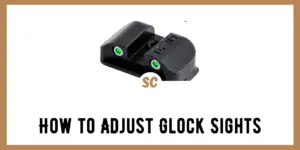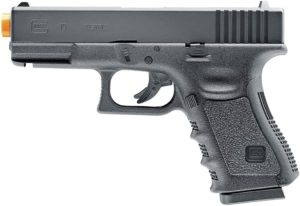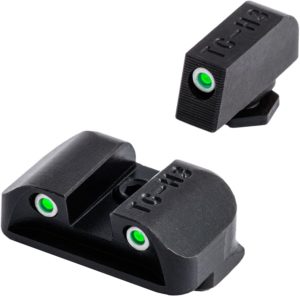Since the introduction of the first Glock 17 to the civilian market, these pistols have become enormously popular. Glock’s reputation for quality, durability, and reliability is almost unmatched. These may not be the prettiest guns in the world, but Glocks are certainly workhorses for many shooters. Many first-time Glock shooters are mystified by the Glock sights. Is it possible to adjust the sights on a Glock pistol yourself?
Glock semi-automatic pistols come standard with both adjustable and standard rear sights. The adjustable Glock sights can be adjusted using the supplied screwdriver for windage and elevation. Glock standard sights fit tightly into a dovetail on top of the slide and are only adjustable for windage. This type of Glock sight is more difficult to adjust and may require special tools.
Many casual pistol shooters never think about the sights on their pistols. These shooters are happy to shoot their pistols the way they came from the factory. However, many of us understand that, just like a rifle, adjusting the point of aim of our pistols gives us better accuracy. Understanding how to adjust both types of rear sights on your Glock pistol is one of the keys to becoming a better pistol shooter.
Is It That Important to Adjust the Sights on a Glock Pistol?
The point of any shooting exercise is to consistently put rounds on the bullseye of your target. If you can’t hit your target with any degree of certainty, then you aren’t shooting. You are just making noise. Every shooter should strive to perfect their technique and abilities to be as precise as possible with their aiming.
Having your pistol sights properly aligned is a key to achieving this goal. If your pistol sights are not properly aligned, you can never hope to shoot accurately. Part of being a well-trained and confident shooter is knowing your pistol, how it functions, and maintaining it properly. Sight adjustment is part of that maintenance that you should understand.
What Types of Sights are Installed on Glock Pistols?
Glock pistols come from the factory with several different sight options. In general, most Glock pistols have manually adjusted sights. Some later models come from the factory with adjustable sights. Some retailers and gun dealers may install aftermarket sights on a Glock pistol as part of a special package. You should be able to determine what kind of sights are on your Glock pistol easily by examining the rear sight.
Manually Adjusted Glock Pistol Sights
Most Glock pistols sold in the civilian market are equipped with Glock’s standard manually adjustable rear sights. The Glock manually adjusted rear sight features a U-shaped sight that slides into a dovetail machined into the top of the slide.
These manually adjusted rear sights don’t have any means of adjusting for elevation. The only adjustment that can be made to these manually adjusted sights for windage by drifting the sight left or right in the dovetail. This takes skill to prevent damage to the sight or the gun slide. There are special tools that can be used to make these windage adjustments.
Adjustable Glock Rear Sights
Some models of Glock pistols come equipped from the factory with adjustable rear sights. These adjustable sights are easy to recognize. These sights have two screws on the sight assembly that can be turned to move the rear sight to adjust for windage and elevation. Most Glocks equipped with adjustable rear sights include a small screwdriver to make these adjustments.
Aftermarket Glock Sights
Many retailers and gun dealers will add aftermarket rear sights to a factory-fresh Glock as a sales incentive. Night sights are a popular choice for these changes. The Trijicon night sights that use a tritium insert to make the sight glow in the dark are especially popular. In many instances, the front sight post is replaced to give the Glock pistol a completely new set of sights.
Adjusting Manual Glock Pistol Sights
Adjusting Glock manual pistol sights can be challenging. The rear sight on manually adjustable sights sits in a dovetail groove machined into the pistol slide. The tolerances of these manually adjusted rear sights are very tight. Nothing but friction holds the rear sight in place in the dovetail.
The action of the slide and the force of the pistol recoil could cause the sight to drift from side to side if the fit is not extremely tight. Moving the rear sight of a manually adjustable Glock can be difficult without the proper tools. Making adjustments to a Glock manual sight can be done in several ways.
Manually Adjusting Glock Sights with a Hammer and Punch
Many Glock shooters manage to adjust the manual rear sights of their pistol using nothing more than a punch and a hammer. This is a cost-effective method of making adjustments to manual Glock sights but does have several disadvantages that should be noted.
The major disadvantage is the chances of damaging the slide or the sight of your Glock pistol using this method of adjustment. The act of placing the punch on the sight and then tapping with a hammer to drift the sight right or left can lead to marring or damage to the dovetail, the slide, or the sight. Extreme caution must be used if you align your sights using this method
For best results, the frame should be firmly placed in a vice. Padding of some sort must be employed to avoid damaging the slide finish. A soft brass punch is also advisable for adjusting the sight. The downside to this method is having a vice available at the range while you are making adjustments. This method also requires that the pistol be disassembled to make the adjustments.
We discourage anyone from adjusting their Glock manual pistol sights at the range using this method. Without a means of securing the slide, there is no accurate or safe way to use a punch and hammer in the field or at the range to adjust your Glock manual sights.
Adjusting Manual Glock Sights with a Glock Sight Tool
Glock does make a special tool for adjusting manual sights on their pistols. The tool can be clamped around the slide of your Glock pistol, and a saddle sits over the rear sight. A micrometer-style wheel is turned to move the rear sight left or right in the dovetail.
One great advantage of the Glock rear sight tool is moving the sight. There is no need to clamp the slide in a vice. The sight tool virtually eliminated the possibility of damaging the sight or the pistol slide. In addition, very small and precise adjustments are possible.
The Glock rear sight tool can be easily used at the range or in the field if necessary. This makes sighting in your Glock pistol much more efficient and effective than the hammer and punch method. Our experience has shown that using a rear sight tool is quicker and allows more precise adjustments even at the range.
The downside is the cost of these rear sight adjustment tools. For many shooters, it is hard to justify the investment in these tools. This is especially true when the tool may be used only once or twice in the lifetime of the pistol. These tools cost more than $100, challenging many shooters’ budgets.
Take Your Glock to a Gunsmith
The last alternative is to take your Glock to a gunsmith. Many gunsmiths have Glock rear sight adjustment tools and will sight in your Glock for a small fee. However, having someone else sight in your Glock pistol may not achieve your desired results.
Accurately shooting a pistol involves many factors. Proper alignment of the sights is just one part. Your stance, grip, and how you approach aiming are all part of the equation. The gunsmith you choose will probably use a laser bore sighter as part of the process. This can give satisfactory results but may not give you the level of accuracy you desire.
Nothing beats sighting in your Glock pistol at the range. Your shooting habits and expectations will probably be better met if you sight in your Glock at the range yourself.
Sighting in Your Adjustable Glock Pistol Sights
Many newer Glock pistols are coming from the factory with adjustable sights. This makes sighting in your Glock pistol much quicker and easier. The Glock pistols that come with adjustable sights also include a small screwdriver to make the adjustments.
These adjustable sights can be adjusted for windage and elevation, giving you a more robust set of adjustments. Competitive target shooters favor this sight style for the more accurate adjustment available.
Sighting in an adjustable sight on a Glock pistol is, in many ways, like sighting in a rifle with iron sights. We suggest that you use a quality pistol vice when adjusting the sights on your Glock. This makes the adjustments more precise since the pistol is held in a rigid and repeatable manner.
Following a few simple steps can have your Glock sighted in quickly if equipped with adjustable sights.
Step 1: Work Safe
Above everything else, you should make sure that your Glock pistol is in a safe condition before you start doing any kind of maintenance. Remove the magazine, clear the gun, and visually check the chamber to make the action clear. Wear your eye protection at all times when working on your pistol.
Local rules can vary if you are making adjustments to your Glock sights at the firing range. Some ranges, particularly indoor ranges, prohibit any kind of maintenance to the pistol on the firing line. Be sure you know any rules at the range where you are shooting.
Step 2: Clamp Your Glock in a Sled to Make your Test Shots
The best way to sight in your Glock pistol is to use a gun sled to hold the pistol. With the Glock pistol clamped into a secure gun sled, you can ensure that your test shots will be repeatable and accurate. When your gun is secured in the sled, aim the pistol at the center of your target. Fire at least three test shots. You can then begin adjusting the sights of your Glock pistol based on the impact points of these test shots.
Step 3: Adjust for Windage
Adjust the windage of your Glock pistol sights first. The adjustment screws are located on the right side of the sight from the rear when you view the sight. The lower screw located toward the front of the sight adjusts the windage. Turning this screw clockwise will move the sight to the right. To move the sight o the left, turn the screw counterclockwise.
Don’t turn the screws too much or too far. There is limited travel for adjusting the Glock sights. You should also understand that a very small change in the rear sight can translate into a lot of distance in the aiming point. Work slowly and carefully. Move the sight left or right as needed and then fire more test shots to see the results.
Step 4: Adjust for Elevation
When you have your Glock adjusted for windage and the test groups are centered right to left on the target, you can adjust the elevation to bring the groups onto the bullseye. The rearmost adjustment screw on the side of the Glock adjustable sights is the elevation adjustment screw.
Make small adjustments to the elevation and fire a few test shots. Slowly adjust the Glock pistol sight until the shot group is on target. Take care and make very small adjustments. The elevation adjustment screw is an eccentric screw that needs to be turned slightly to make corrections.
Which Way Do I adjust the Rear Sight?
In general, the sights on your Glock pistol should be moved in the direction you need to correct. In other words, if the pistol is consistently grouping to the left of the target, you should move the rear sight to the right. This will bring the aiming point to the right. Conversely, if the pistol consistently groups to the left of the bullseye, move the rear sight to the left.
Remember, those very small movements of the rear sight on a Glock can make big differences downrange to the impact point. Working slowly and making small corrections between test shots is the key to bringing your Glock pistol back on target.
Getting Your Glock On Target
Once you are certain your Glock sights are set correctly, you can begin working on your technique to improve your pistol shooting accuracy. The confidence that knowing your Glock shoots where you aim is a wonderful experience. Spending the time to sight in your Glock pistol properly will help your shooting technique and your ability giving you a much more consistent and accurate result.









![5 Keys To Survival Bartering [PODCAST] 5 Keys To Survival Bartering [PODCAST]](https://survivalcove.com/wp-content/uploads/2021/09/The-survival-show-podcast-banner-370x297.jpg)




















